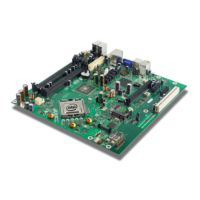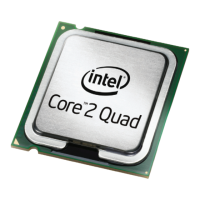Low Power Features
22 Datasheet
NOTES:
1. All common clock signals will be active for two BCLKs instead of one (e.g., ADS#, HIT#).
2. The double-pumped signal strobes will have only one transition per BCLK when active,
instead of two.
3. The quad-pumped signal strobes will have only two transitions per BCLK when active,
instead of four.
4. Same setup and hold times apply, but relative to every second rising BCLK.
5. Following a RESET#, the bus will be in the legacy full-frequency mode.
6. There will not be a down-shift right after RESET# deassertion.
7. There is no backing out of a transition into or out of half-frequency mode. Once the
sequence starts it must be completed.
2.4.2 Enhanced Intel® Dynamic Acceleration Technology
The processor supports Intel Dynamic Acceleration Technology mode. The Intel
Dynamic Acceleration Technology feature allows one core of the processor to operate at
a higher frequency point when the other core is inactive and the operating system
requests increased performance. This higher frequency is called the opportunistic
frequency and the maximum rated operating frequency is the ensured frequency.
The processor includes a hysteresis mechanism that improves overall Intel Dynamic
Acceleration Technology performance by decreasing unnecessary transitions of the
cores in and out of Intel Dynamic Acceleration Technology mode. Normally, the
processor would exit Intel Dynamic Acceleration Technology as soon as two cores are
active. This can become an issue if the idle core is frequently awakened for a short
periods (i.e., high timer tick rates). The hysteresis mechanism allows two cores to be
active for a limited time before it transitions out of Intel Dynamic Acceleration
Technolog y m o d e .
Intel Dynamic Acceleration Technology mode enabling requires:
• Exposure, via BIOS, of the opportunistic frequency as the highest ACPI P state
• Enhanced Multi-Threaded Thermal Management (EMTTM)
• Intel Dynamic Acceleration Technology mode and EMTTM MSR configuration via
BIOS.
Figure 3. Dynamic FSB Frequency Switching Protocol

